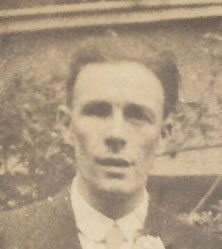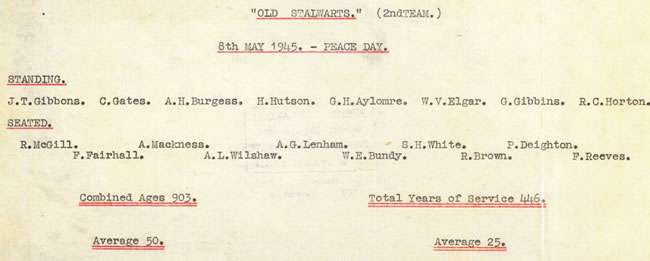| The Burgess family in the First World War | ||||
|
Memorabilia
|
There are now eleven young men from the wider Burgess family who I have found served in the army in the First World War. For a few I have included pictures of them, identified by their name written on the back of the photo by Rose Burgess. If there are any more First World War family portraits out there I would be pleased to add them to the page, along with any relevant records of their service. __________________________ I shall begin with three brothers who all survived the war but not unscathed. Albert, Charles and Reginald were the sons of Charles Edward and Emily Flower. Emily was the eldest daughter of James Joseph Hely and Tamson Deane. Her husband, Charles Edward, died in 1903 and they had lost a fourth son, John Wesley, in 1901 when he was still a baby. She must have had many misgivings when she saw the three of them joining up. Albert Henry Flower 1895 - 1945 Albert joined the 1st Wiltshire Regiment and although I cannot find much evidence of his war service I do know that he sustained a gun shot wound to the left hip and was awarded a pension in 1919 to commence the day after he was discharged on 3 February. He was listed as Private Albert H Flower, 23346 on his medal card but the pension document stated that he was a lance corporal by 1919. It also gave his address as the Theological College, Lichfield which is confirmed by this entry in Crockford's Clerical Directory of 1932.
Albert's subsequent career in the Church was described in the Essex based newspaper, the Newsman-Herald, with the announcement of his untimely death in 1945.
In " A Brief History of St Barnabas Church" The Reverend Albert Flower was described as "a kindly man with great pastoral gifts. He was to die in office early in 1945 at the age of 48".
Charles Frederick Flower 1892 - 1968 Charles was the eldest of the three brothers and he enlisted on 30 November 1914, initially in the 24th Battalion, London Regiment as part of the Territorial Force, where he was alloted the first of several regimental numbers: 3311. In April 2016 his number changed to 722586 when he was mobilised, and he sailed for Le Havre on 25 June that year. As well as active service in France his record shows time spent in Salonica, Palestine and France again, with a hospital stay in Cairo in 1918. He remained with the 24th London until 20 March 1919 and then transferred to the RAOC in January 1920 after a period on Reserve. His new regimental number was S/11232. In between he married Jessica Edith Ash on 20 September 1919 at St Lukes Church, Camberwell. Charles appears to have had issues with officialdom because in 1917 his record mentions loss of pay for not complying with an order and again for losing by neglect his green identity disc. Matters didn't improve, as is shown by this extract from his service record listing the times he was in trouble, including insolence to a N.C.O. and disobedience of orders, before he was attached to 181st M. G. Coy, (Machine Gun Company) as a mule leader. Did someone think this was poetic justice?
On each occasion his punishment was F.P.No.1, or Field Punishment No. 1, for varying and increasing numbers of days. This meant that Charles was secured, standing full-length, to a fixed object - either a post or a gun wheel - for up to two hours a day (often one hour in the morning and another in the afternoon) for up to 21 days. It had replaced flogging in the Army in 1881. When Charles joined the RAOC in January 1920 it was possibly a much more fitting posting for him than driving mules, as he was a warehouseman or storeman all his working life. However he was declared medically unfit a year later and discharged with a pension. By this time he had a daughter named Jessica, after her mother. Reginald Edward Flower 1898 - 1932 The youngest brother, Reginald, enlisted in the 6th London Regiment with No. 6921 and then transferred to the Royal Irish Rifles as Rifleman 45057 in the 16th Battalion. The Battalion landed at Le Havre in October 1915 and served on the Western Front throughout the war.
Medal Entitlement Roll for Royal Irish Rifles Reginald married Florence Maud Munt on 21 July 1928 at Lady Margaret Church, Walworth, Southwark, and the service was conducted by the curate, Reginald's elder brother Albert H Flower. Unfortunately Reginald died aged just 33 in 1932. In 1918, all three brothers were named in the Absent Voter Lists for the London Borough of Southwark, living at 34 Guiness Buildings, Brandon Street (Block B), which was their mother's address. Conveniently their Regimental Numbers were included in these lists and so confirm their identity in other WW1 records.
__________________________
George Robert Newbury 1886 - 1942 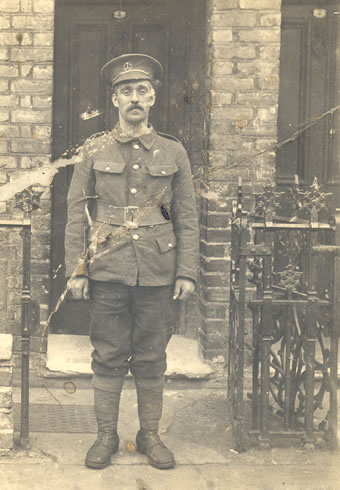
Private George Robert Newbury, G/10726, was one of Jane Newbury's brothers. He volunteered in May 1915 and joined the Middlesex Regiment, serving in France from 14 December 1915 until February 1918. After leave, he returned to France, serving until 19 March 1919. He received a pension, having suffered a gunshot wound to the right foot. He was also hospitalised for a gunshot wound to the scalp in April 1916. George has an entry in the National Roll of the Great War: an attempt to compile short biographical descriptions for as many as possible of those who served in the War. George's entry states that he took part in many engagements including those on the Somme and at Arras, Ypres and Cambrai. His Medal Card confirms that he holds the 1914-15 Star and the General Service and Victory Medals. The photograph appears to show George standing outside his home: 4 Bayonne Road, Fulham.
__________________________
Percy William Morris 1880 - 1945
Driver Percy William Morris, 178955, was married to Sophia Charlotte Newbury, one of Jane Newbury's sisters. Having worked with horses as a cabman before he volunteered, he was selected for enlistment into the Army Veterinary Corps on 17 December 1914. He was then transferred to the Royal Field Artillery as a driver and arrived in France on 23 December 1914. Notice the spurs and whip. On his Medal Card are listed the 1915 Star and the General Service and Victory Medals.
Sophia and their children
__________________________ Edward John Parker 1897 - 1916 Edward was the son of George Parker and Mary Ann Newbury, one Jane Newbury's sisters. He enlisted in May 1915 when he stated he was a milkman. After training with the 27th Bn. he joined the 23rd Bn. Middlesex Regiment, also known as the 2nd Football Regiment. His Service Record states that he joined the B.E.F. (British Expeditionary Force) on 3 May 1916.
Private Edward John Parker, F/1459, 23rd Bn. Middlesex Regiment is remembered on the Thiepval Memorial. Link to CWGC commemorative certificate for Edward John Parker __________________________
George Ernest Mark Rice 1891 - 1956
George Rice was a nephew of Mark Burgess, but which of these six is George? His full name was George Ernest Mark Rice and, according to the Airman's Service Records, he had a varied career in the forces starting in the Norfolk Regiment, before transferring to the Essex. It looks very like the cap badge of the Essex Regiment that these six are displaying.
After a further transfer to the Royal Defence Corps he appears to have joined the RFC as a Rigger and spent three months in Russia in 1919, by which time he was classified as A. Mech. 3 in the RAF. He was put on the RAF Reserve list in June 1919 and was "deemed discharged" on 30 April 1920.
George was born in 1891 but not baptised until 22 November 1897 - along with two brothers and a cousin (Joseph Stephen Burgess - see below) at the same time. His parents were Henry James Rice and Winifred Burgess. In 1911 he was working as a French Polisher and two years later he married Annie Sparks on 12 May, when one of the witnesses was Mark Burgess. His Service Record gives his service number: 104146; height: 5 feet 3¾ inches; chest measurement: 31 inches; the names of two sons: Leonard Charles George and George Henry; and Annie's address at 33 Queen Street, St Pancras. __________________________
Joseph Stephen Burgess 1896 - 1917 I have no photograph of Joseph Burgess, only military records.
The entry in the index of the Commonwealth War Graves Commission for the grave of Joseph Stephen Burgess Joseph Stephen Burgess was the nephew of Mark Burgess. His parents, Joseph Mark Burgess and Georgina Stevens, were married on 2 August 1891 at St Michael’s Church, St Pancras, and he was born on 28 November 1896, the third of nine children. Both his father and grandfather were horsekeepers but aged 14 he was described as a “Van gard on Railway” according to the 1911 census. Joseph enlisted in the 1st Batallion London Regiment (Royal Fusiliers) on 30 August 1915 at Handel Street and served until 19 June 1917, when he died “In action”. He had survived the Battle of Arras in April 1917 and, as the War Diary describes, his Battalion had moved to WANCOURT LINE on 11 June. On the 19th they moved again and the War Diary simply reports “Battn. moved into reserve area, about the HARP (N1b) one other rank killed, two wounded”. At some point Joseph had been promoted to Corporal and this was recorded by the Imperial War Graves Commission along with the name of the Cemetery: Tilloy; his number: 200742; age 20; and next of kin: Mrs L W Jarvis of 11 Harmood Place, Chalk Farm, NW. Lydia Winifred Jarvis, née Burgess, was Joseph’s elder sister by 3 years. She was also named as the sole legatee on the Soldiers’ Effects Register, receiving £6:19:1 initially and then £14 War Gratuity. Also included in this register is his original regimental number: 2578. Joseph is remembered in the records of the National Railway Museum, listed amongst the Railwaymen Died in The Great War, where he is described as Vanguard with the London & North Western Railway. The source is St Paul’s Order of Service 1919: a memorial service for railwaymen held on 14 May that year. Link to CWGC commemorative certificate for Joseph Burgess __________________________ James Charles Hordle 1872 - 1955 Another relative for whom I have no photograph.James Charles Hordle was born on 19 April 1872. He was a cousin of Henry Burgess. His father Charles was one of Jane Hordle’s brothers in Wareham. James followed the same career path as both his father and grandfather when he took up carpentry as a trade. This may well have influenced his service destination in WW1. He married Frances Mary Selby on 7th October 1899 and by the 1901 census the couple were living in West Street, Wareham with James’s widowed mother Emma Hordle. James joined the Dorset Regiment Volunteer Force in 1900, on 21 March, and continued to serve when the Territorial Force was created in 1908. His service record lists his attendance at 4th Bn Dorset Regiment Annual Training between 1908 and 1913 and states that he was promoted to lance corporal in 1908 and corporal in 1911. He was embodied (the Territorial equivalent of mobilisation) on 4th August 1914 when he was already 42 years old. It isn’t clear what his role was initially, but in 1917, after transferring for a fortnight to the Devon Regt., and just nine days after his 45th birthday, he was transferred to the Labour Corps Home Service. He was then discharged from active service on 25th September the same year for medical reasons.
Medical report from August 1917 He could apparently hear a ticking watch close by his left ear but the right was quite deaf and he couldn’t hear words of command. Not helpful in the Army. The reference to “great noise produced by machinery” might suggest that his duties involved working with heavy equipment. His discharge sheet states that he was “A sober man of excellent character. Disability aggravated by military service.” In 1917 he returned to his family in Wareham and he was still there in 1939, this time working as a junior school caretaker. __________________________
A photograph taken in Kennington Park in 1914
Reginald Walter Burgess 1897 - 1970 “Uncle Reg”, at 17, was not old enough to volunteer in 1914 but that didn’t stop him from signing up alongside his older brother, Albert. However, he was soon found out and on 21 September 1914 he was transferred to the Labour Corps where he served until 28 June 1919, according to the Roll of Individuals Entitled to the “War Badge” (Now known as the Silver War Badge). This document also states that he was a Lance Corporal.
Medal Card for Reginald W Burgess
Both the Medal Card and the Labour Corps Roll of those entitled to the Victory Medal and British War Medal conveniently bring all his war service together by giving his name, his Labour Corps Number (565054) and his 24th London Regimental Number (720925). Reginald Burgess is pictured here in uniform, including what looks very like the 24th Battalion, London Regiment cap badge, so presumably the photograph was taken soon after he volunteered, but before he was transferred to the Labour Corps. At the bottom the message reads "To Bert with Best love Mother, June 1918". Did she send it to her other son, Albert, who at that time was serving in the Egyptian Theatre of War, according to Albert's medal entitlement record?
Albert Henry Burgess 1893 - 1968 At some point during his time in the army, Albert Burgess, 720906, was promoted to sergeant and served until he was shot in the right eye and lost his sight on that side. His hospital record states that he had served four complete years and that the operation described below was carried out on 19 September 1918, so he was wounded very late in the war. The Record of Operations Performed, and Results:
"2/24 London: 720906: Sgt Burgess A : GSW Eye (R): Evisceration Eyeball, Lower lid sutured: Capt Buchanan 19/9/18: Satisfactory: 20/9/18 To UK per HT Gloucester Castle"
Here is Albert pictured at his wedding in 1922, four years after he had lost his eye. Are there enough similarities?
"1925 L/Cpl A. H. Burgess" was still supporting the war effort in World War Two as this photograph shows.
On the reverse is a key to the "2nd Team", whatever that means.
At 52 years old Albert was just over the average age of the 51st Kent Battalion Home Guard. __________________________
Return to First World War page
| |||
| Top of Page |

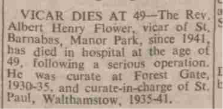 Newsman-Herald; 23 February 1945
Newsman-Herald; 23 February 1945 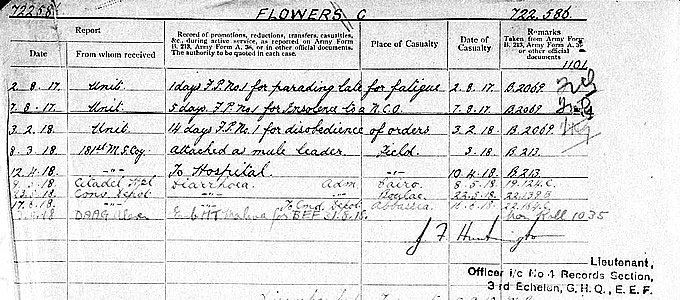

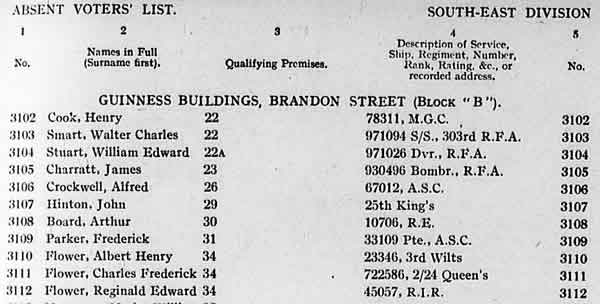
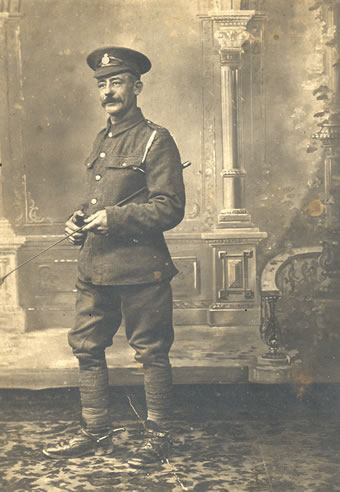

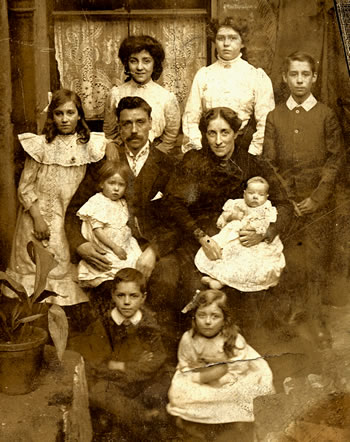 Edward is shown standing at the right in this 1911 photograph of all the Parker family. In his short time in the Army he was promoted to L/Cpl in December 1915 but lost his stripe in April 1916 for being absent over a weekend. In September 1916 he was listed as missing and on the 15th he was presumed dead. After the war the family of a deceased serviceman was sent the medals he had been awarded. A poignant reminder for his mother who signed the receipts.
Edward is shown standing at the right in this 1911 photograph of all the Parker family. In his short time in the Army he was promoted to L/Cpl in December 1915 but lost his stripe in April 1916 for being absent over a weekend. In September 1916 he was listed as missing and on the 15th he was presumed dead. After the war the family of a deceased serviceman was sent the medals he had been awarded. A poignant reminder for his mother who signed the receipts. 

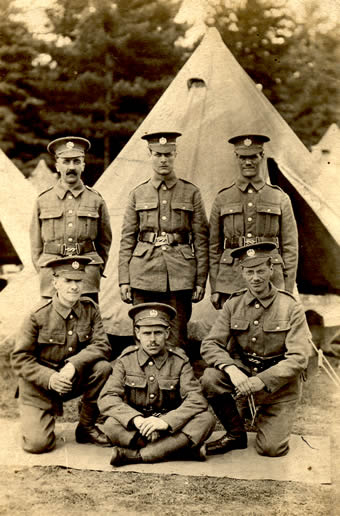


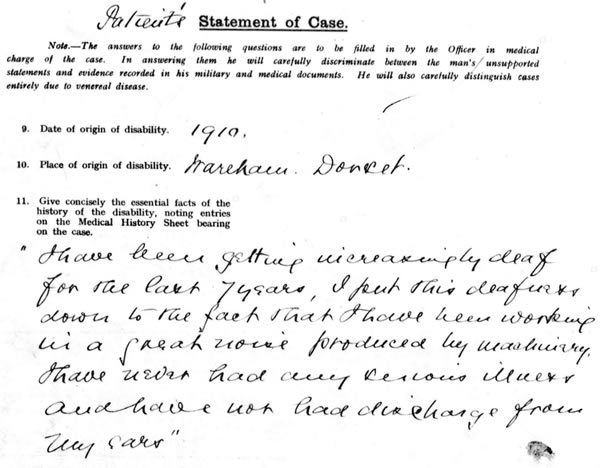



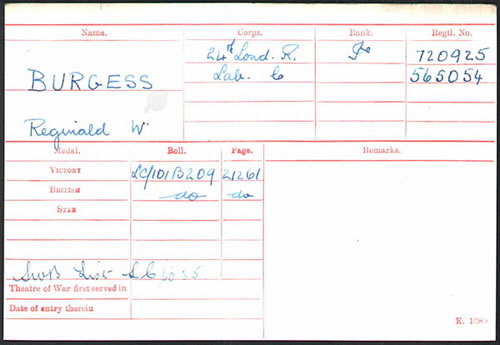

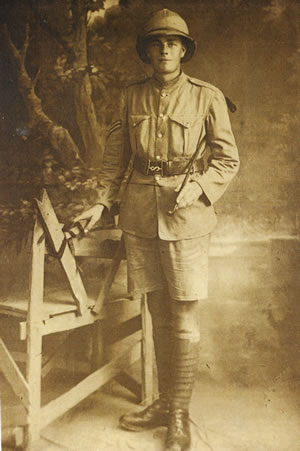 Could this be Albert Burgess in tropical uniform? For some of the war he served in Egypt. There is no cap badge but he does have two stripes so maybe he had just been promoted. The photo is in the collection of his brother Reginald's family
Could this be Albert Burgess in tropical uniform? For some of the war he served in Egypt. There is no cap badge but he does have two stripes so maybe he had just been promoted. The photo is in the collection of his brother Reginald's family 